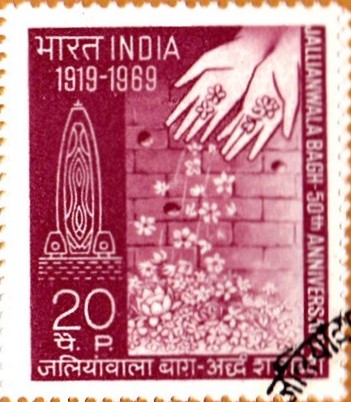
Jallianwala Bagh 1969
A commemorative postage stamp on the 50th Anniversary of Jallianwalla Bagh massacre (Amritsar massacre) :
 Issued by India
Issued by India
Issued on Apr 13, 1969
Issued for : It is on the foundations laid by the martyrs who fell on that fateful Sunday that the edifice of our liberty is built. A grateful nation is observing the 50th anniversary of this portentous event. The P & T Department considers it a privilege to commemorate the occasion by issuing a special postage stamp.
Description of Design : The design of the stamp is vertical and depicts a portion of a wall with bullet marks and showing two hands dropping flowers near the wall. The Jallianwala Bagh Memorial is shown at the left.
Type : Stamp, Postal Used
Colour : Maroon
Denomination : 20 Paise
Overall Size : 3.34 X 2.88 cms.
Printing Size : 2.98 X 2.52 cms.
Perforation : 13½ x 14
Watermark : Printed on unwatermarked paper
Number Printed : 30,00,000
Number per issue Sheet : 42
Printing Process : Photogravure
Designed and Printed at : India Security Press
About :
- April 13, 1919 marked the turning point in India’s struggle for independence. Earlier, Indian nationalism had been led largely by peace-loving liberals. The tide had already begun to turn with the initiative taken by leaders like Bal Gangadhar Tilak who were not content with playing a passive role in the quest for freedom. When the nationalist leadership passed to Mahatma Gandhi soon after his arrival from South Africa, the “talking” phase of the freedom movement was giving place to an “active” phase, a phase wedded to truth and non-violence but not stopping short of open defiance of authority. Indian nationalism was coming of age and Jallianwala Bagh was the watershed.
- The British rulers naturally tried to put down these manifestations of what they called sedition. The Rowlatt Acts were devised to quell the rising tempo of nationalist activity. The Acts only gave a legal cloak to the measures considered necessary for putting down the “natives” with an iron hand. The coming into force of these Acts on 23rd March, 1919 aroused a wave of anger throughout the country. Mahatma Gandhi called for a passive resistance movement against the unjust Acts.
- The whole country responded to Gandhiji‘s call, but it was in the Punjab that the movement was the strongest and most widespread. Amritsar was in the vanguard of this “satyagrah“. The authorities thought that they could suppress the spontaneous expression of the people’s will by arresting the prominent leaders. Dr. Kitchlew and Dr. Satyapal were arrested on 9th April and sent away from Amritsar. This only fanned the flames of popular discontent. Amritsar was plunged deeper into civil disorders. There were firings on demonstrators resulting in deaths and injuries and this led to further demonstrations by the people. A few Europeans were killed.
- The British Civil Officers on the spot apprehended that they had lost control of the situation. The military were called in and General Dyer took charge of the city. On the morning of the 13th April he caused proclamation to be read prohibiting public meetings. This proclamation was not heard by many people, more especially because the Baisakhi Mela was to be held later that day to which the people from the out-skirts came in large numbers. A meeting was held at Jallianwala Bagh that evening, despite the ban. About 25,000 people had assembled for the purpose. At about 5 P.M., General Dyer proceeded to the spot with ninety of his troops. He ordered fire to be opened straightaway and without warning. The crowd could not disperse because no exits were available. The firing was intense and continuous for about 10 minutes. It was especially directed at the corners where the gathering was the thickest. The firing was stopped only because the ammunition ran low. Dyer withdrew at once leaving the wounded and the dying to their fate. It was soon dusk and the curfew prevented people from taking away the dead bodies or succouring the injured. It was estimated that 379 people were killed and about 1200 wounded. But the exact numbers will never be known.
- There are few parallels in history to this act of wanton brutality. But it served as a rude reminder to the country that freedom could not be attained unless the price for it was paid. Those who had thus far been only disinterested onlookers were also shocked into joining the national cause. Even the British rulers could not dismiss the occurrence as an isolated case of the excessive use of force. An enquiry was held and General Dyer was retired.


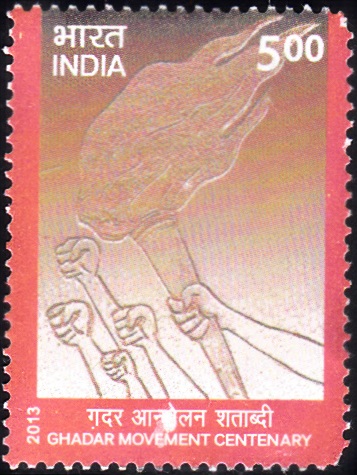

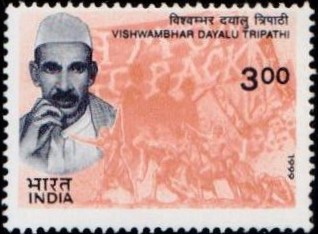
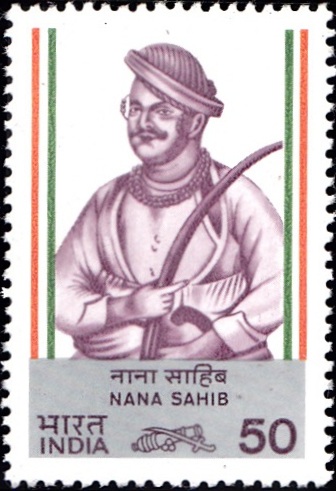
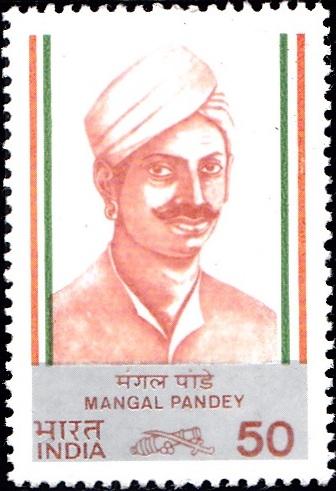
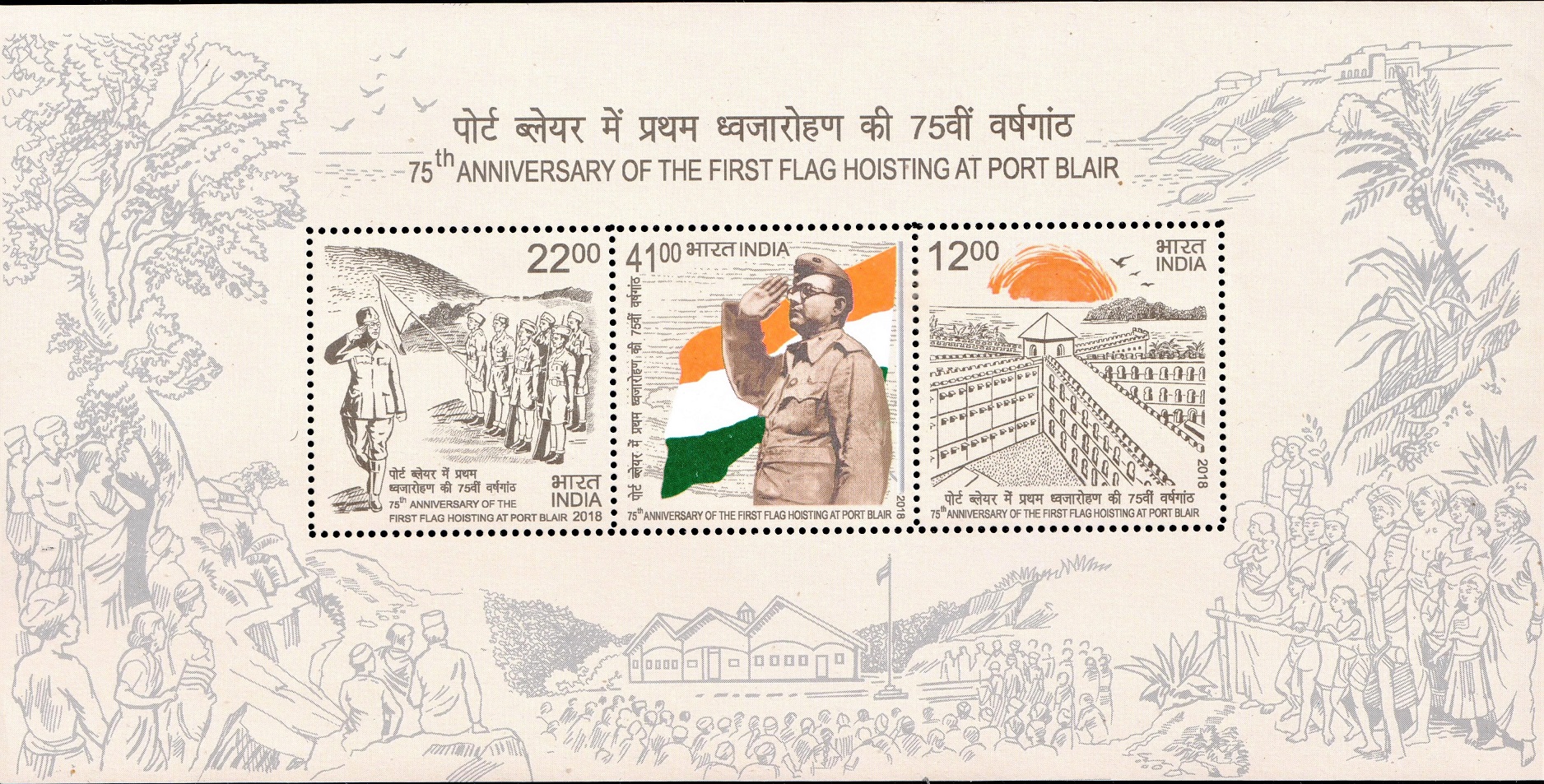
[…] 13th April, 1924, the song was first sung in a gathering at Phulbag, Kanpur in remembrance of the Jallianwala Bagh incident. The gathering included late Pandit Jawaharlal Nehru, the first Prime Minister of […]
[…] fifty-four years ago on this very day, several hundred patriots fell at Amritsar‘s Jallianwala Bagh to bullets fired by troops under the command of General Dyer. They formed part of an unarmed crowed […]
[…] a lawyer he took up the defence of those implicated in the aftermath of Jallianwala Bagh massacre. No one was allowed to travel outside Amritsar under the Martial Law then in effect, but […]
[…] also met Gandhi the same year at Santiniketan. He renounced his Knighthood in protest against the Jallianwala Bagh Massacre in […]
[…] political career started against the background of the Rowlatt Act and the Jallianwala Bagh tragedy. The latter incident affected him profoundly. He left college and plunged into the freedom […]
[…] like the “the Scream” series and “Peace restored in the Punjab“ (on the Jalianwala Bagh tragedy) were distinguished by the artist’s unfailing courage and directness and left a […]